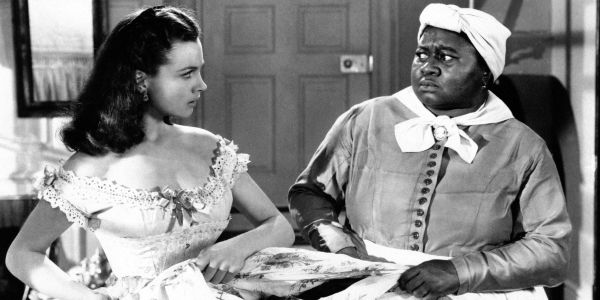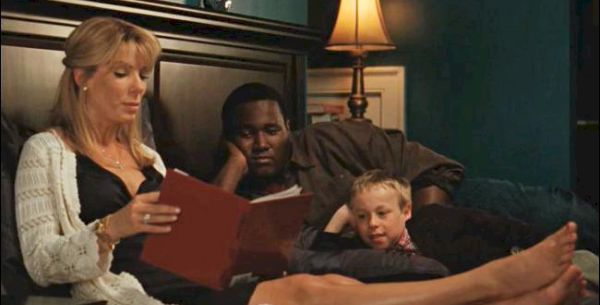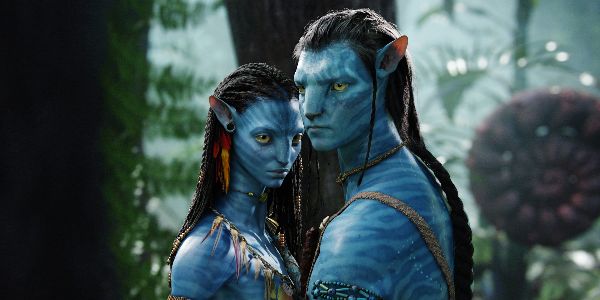BLACK OSCARS From Mammy to Minny: INTERVIEW with Professor Frederick Gooding Jr.

Tynan loves nagging all his friends to watch classic movies…
Frederick Gooding, Jr. is an associate professor of African American Studies at TCU, who published a book entitled: “Black Oscars: From Mammy to Minny, What the Academy Awards Tell Us about African Americans.”
Professor G graciously agreed to speak with Film Inquiry, providing a bevy of his insights on the Oscars and the movie industry as a whole:
This is Tynan Yanaga with Film Inquiry. You’re obviously a passionate movie lover as well as a professor. What compelled you to put together this analysis, and what do you hope to accomplish?
Professor G: I know firsthand that the movies, like no other medium, have the ability to touch us and transport us across time and space. They conjure deep, powerful emotions and create a common context and dialogue by which we’re able to come together.
I developed a love for movies just watching them with my mother – movies are a relatively inexpensive way to entertain children. My mother would be my first film teacher, in terms of the inside jokes that we can cultivate – did you see that part – and we would rewind the videotape. Notice, I said videotape.
Yes, I do recall VHS!
Professor G: Right, we would share these moments and there are so many things that are going on at once. I think that’s the power of it, the idea that we all can have a favorite movie and we can watch it over a period of years and still see something new that you haven’t seen before. I think that’s what’s so amazing about this, and it provides some of the context as far as my love for movies.
Also, being a black male in the United States of America, I cannot help but bring into the theater a certain perspective that literally colors what I see on the screen, and after a time, I just started to notice patterns when it came to African American images, so that inspired me to dig a little deeper.
The subtitle of your book includes “Mammy to Minny.” Could you explain why these two names are so important to what you are trying to discuss?
Professor G: Hattie McDaniel‘s Mammy is the first-ever black Academy Award winner, but the question is, what does she win it for – she won it for her best supporting role in Gone with The Wind in 1939. In many ways, the role reflected the reality of many African American women off-screen. Roughly up to 80% of all black women in the South are working as domestics up until World War Two.
I think it is a good way to anchor the book’s analysis, because we fast forward and Minny is also the name of an Academy Award-winning supporting character, Octavia Spencer, also playing a black maid on screen. So if she wins this award in the modern era and we’re still talking about black women winning Academy Awards playing subjugated maids over seven decades apart, the question is, what has changed?
-

Gone With The Wind (1939) – source: MGM
What do these Oscars reflect to us about the value and visibility of black people in society? Because arguments can be made that in 1939 that simply was the way. My counter would be, that may have been the commonly accepted way, but it still wasn’t the right way. I still think people knew what subjugation was — I think people still knew about power dynamics and things of this nature. Hattie McDaniels tried to do the best with what she had, but unfortunately, the black spectrum was so very limited.
If times have changed, what’s so fascinating about watching a black woman serve and take care of other people on screen in the modern era? That’s what got me thinking about this larger question about the value of quality black images on screen and that’s the pretext for this larger conversation, what is the true value of the black image in society?
Unfortunately, the current events are very much reminding us of how many are still experiencing this tension over the quality of black life. I don’t know how you can explain that you take an oath and pledge to preserve the sanctity of human life, but yet you fail to move your knee off a handcuffed individual, who’s lying prostrate on their stomach, who’s unarmed, for nearly nine minutes. I don’t understand how that can happen; maybe the only way that can make sense is if you ultimately did not recognize this person’s full humanity in the first place.
If you and I just stepped on somebody’s foot for three seconds, “Oh, excuse me, I’m sorry.” I mean it’s just a natural reaction. I can’t explain the depravity and not to mention Daunte Wright, in the same city, just days ago. In other words, our work is not done.
One of the terms you used in your analysis is “The Gravity of Reality.” Can you explain how you use this term and what it means?
Professor G: Many of us are accustomed to seeing black images, but only within a certain context, and we will notice that it’s no statistical aberration that the largest category of black Academy Award nominees are in the best supporting categories, to the extent that blacks are able to render aid to our protagonists who are most often white.
“Gravity of Reality” refers to this idea that typically when we see black images on screen, they are defined by a very narrow spectrum, meaning that I found in my research over 80% of all black Academy Award nominees were roles that dealt specifically with either issue of racism or poverty.
What we want to do is contrast. For example, people say, “What’s your problem? Don’t you like movies like Fences and Ma Rainey’s Black Bottom?” In many ways, I’m glad these movies are being made because they help complicate the spectrum of black images, but the catch is these movies are typically insular, meaning they only feature black people. Therefore, if you only have black people in the movie, you have to develop somebody’s character. The issue is when you have blacks and whites sharing the same screen, the hierarchy emerges.
We often see that our white brothers and sisters are liberated by the freedom of fantasy so it’s not unusual for us to see two white teenagers in a spherical rotating gyro sphere that can travel throughout a park where dinosaurs are roaming around. I’m referring to Jurassic World. That’s the stuff of fantasy.
So, often our white brothers and sisters are liberated by the freedom of fantasy, and yet when it comes to black, indigenous, people of color, that’s when you hear the arguments about, “We can’t be anachronistic, we have to keep it real.” In many ways, it’s a shorthand excuse for Hollywood not to flex its creative juices.
-

The Help (2011) – source: Walt Disney Studios
I don’t want to hear, when you come up with a movie like The Help, that it has to be factually true. Two quick responses: It’s not a documentary. It’s a product and the fabric and the fiction of a white female’s imagination, Kathryn Stockett, and if it’s not a documentary, my second response would be then, how do you explain Abraham Lincoln Vampire Slayer?
It leads me to wonder is there too much weight put into the Oscars as a showcase for images?
Professor G: The Academy will not like me saying this, but the answer is yes, and here’s the reason why. Your question exposes a dirty little secret that many of us often completely ignore. It’s almost like this idea that we all agree that Santa Claus exists for a couple of weeks of the year. The Academy Awards actually are a private function celebrated publically. You and I have no say in the matter, but yet we watch.
They were very savvy in the 1920s to bond together to figure out a way to protect the industry. It’s hard to imagine, but there was a time when movies were purportedly supposed to provide this pernicious influence on society. A lot of people did not trust the new medium. They did not know the scope of its full applications and many were concerned.
I think Louis B. Mayer along with a couple of other big wigs decided what can we do to protect the industry, and they felt that by recognizing the best in the business they would generate goodwill, not only with those within the industry, but also those without. Fast forward many years later, their prophecy has come true. If anything, this is a bigger deal to people outside the industry.
Even though the Academy has made some changes and is still making strides in terms of new criteria for films that are eligible, there still is too much mystery that surrounds the process. We still don’t know the exact number of voters and who they are, and how they’re selected.
If we look at the aftermath of the #oscarssowhite movement, we know that more people of color received invites, but is it just to check a box? It seems rather capricious. What was the criteria? Do you have to be in the film industry or is it just because you’re black or a person of color. I think there’s still a lot of questions.
I like the idea that there are the Hulus, Netflixes even Amazon Primes of the world, but only time will tell whether they will be able to generate the type of political, social capital that the Oscars have. Because, for right now, the Oscars are the big dog on the block.
When I think of representation, having more quantity seems like a positive starting point. You also made the distinction of wanting quality images. What should we be looking for?
Professor G: It is absolutely imperative we look at more holistic ways of measuring diversity, equity, and inclusion. I’m not saying that numbers are of no value. I mean I’d be a fool to say such, but numbers oftentimes only tell us part of the story. I think rather bluntly, we could use some simple rubric — it’s not just whether we feel good about the individual, but a more critical rubric might be power and control.
For example, The Academy Award-winning Blind Side with Sandra Bullock, who won Best Actress. If you total up the number of minutes, then the character of Michael Oher had a lot of screen time. He’s played by Quentin Aaron – a lot of people don’t know his name. But you can make the case in good faith that the movie is about him. It’s about his life. He’s a football player. He’s a person who is lost, and then he was found and then found salvation through this new family, etc.
-

The Blind Side (2009) – source: Warner Bros. Pictures
But when we look at his role through the rubric of power and control, we see that the quality of his role rates rather poor and that he had virtually no agency with what was going on in his life. There are very few decisions he made that were significant. The only time we actually see Quentin Aaron display any type of ferocity or tenacity was towards the end of the movie when it was to defend a white woman’s honor.
This rubric would be quite telling in terms of what degree black characters have the same latitude in being able to make a decision that will influence the audience’s experience. Because the last thing I’ll say is that, when it comes to so many of our white protagonist heroes and heroines you see this all the time. In fact, that’s what we go to the theater expecting.
What is Bruce Willis going to do now? His feet are bandaged. He’s bloodied. There is glass all over the floor in Die Hard, but we were willing and waiting for him to make this next crucial decision and hopefully, he’ll save the day. There are numerous examples of white characters who exercise power and control but, honestly, when it comes to our black, indigenous, people of color, those movies, are still far and few between.
If we have more black creatives do you think that this is something that could lead to change or are there still deeper ingrained issues?
Professor G: I’d be lying if I said it was not an uphill battle. Writers Guild of America is roughly 90% white and so it’s not to say all white people are evil, it’s just to say that most of the stories we see are marked by typically one dominant perspective.
If we’re able to diversify the number of perspectives in the room, I think we stand a better chance of producing a higher quality product that audiences will like, and I think Bridgerton on Netflix is an example — a highly rated television program by Shonda Rhimes, who used to work for ABC. And I think it’s showing that through diverse casting, mixed in with some fantasy and romance, you can produce something that many people like.
It’s not the creative mandate. I was able to watch The King’s Speech and enjoy it, even though there’s nobody in there who looks like me. So you can’t legislate art in that respect, but at the same time, I think today we’re missing out.
When we do think about the stories that do make it to the big screen, as far as black protagonists are concerned, I discovered that most of the movies that feature black protagonists that have been nominated are what I call para-realistic movies, meaning that, if you look at Dream Girls, Last King of Scotland, 12 Years a Slave, Green Book even Glory, all these are movies that are based upon extra-ordinary, true-to-life stories.
-

Avatar (2009) – source: 20th Century Fox
While it’s nice that the stories are being brought to screen, even Ali and Ray, I still think it demonstrates a lack of creativity on Hollywood’s part that the only way that I can get writers in a room and excited about showcasing black protagonist is if the story has already been told before. In other words, a lot of work has been done through shorthand — a lot of people know about this character — all I have to do is just take a little bit of artistic license and make it for the screen.
My challenge would be, how do we start from scratch? Avatar blew my mind! I love it. You love it, but somebody started from scratch. They created this world, and I think the same infectious captivating powers of creativity can be equally applied across the board. I like to think that if there’s one space where we are without limit our bounds it will be within the safe haven of imagination.
If we have such a narrow conception of black images, how do we broaden our understanding?
Professor G: This is definitely a tough one. It’s not going to happen overnight. I think one way to get started is by continuing to patronize some of the smaller stories. I referenced earlier the Hulus, Netflixes, and Amazons of the world.
I think they have a bit more artistic license because when you’re talking about a series that has eight episodes or maybe four or five or six seasons, you just have more room to experiment. You can try things and see what works and what doesn’t and, ironically, with a tentpole movie, you only have three hours or less to get it right. There’s a lot riding on it.
Hollywood likes to make money so if they know that the pattern works and people like it, that will be a financial incentive for them to do so, but the other piece, I would like to think that we can be a bit more clever leveraging the technology in front of us.
I think there’s a fair argument that back in the 1930s, whatever Paramount Pictures made, we just had to swallow it. That was it. But I’m inspired by the Issa Raes of the world, who took her show to YouTube, and lo and behold, she starts making the Awkward Black Girl series online that’s discovered by HBO and the rest is history. Now she’s starring in a romantic comedy of her own opposite a Pakistani-American character in The Lovebirds.
By her taking the available technology into her own hands and still raising her voice that was the key to her breakthrough, and I like to think that there are so many creative minds who create absolutely brilliant memes and Tick Tock videos to the extent that a couple more can start to concentrate and focus on how to amplify their voices through existing mediums.
Because, right now, the studio system is difficult to penetrate. You have a small group of people making these very important decisions with millions of dollars on the line so I understand this idea of wanting to go with what feels comfortable and going with people with whom you feel comfortable.
That being said, I just want to remind anyone who’s reading that we are potentially missing out on a plethora of talented individuals if we don’t make ourselves more open to the art of the possible.
This interview was edited for length and clarity. On behalf of Film Inquiry, thank you again Professor Gooding Jr. for taking the time to speak with us!
Does content like this matter to you?
Become a Member and support film journalism. Unlock access to all of Film Inquiry`s great articles. Join a community of like-minded readers who are passionate about cinema - get access to our private members Network, give back to independent filmmakers, and more.
Tynan loves nagging all his friends to watch classic movies with him. Follow his frequent musings at Film Inquiry and on his blog 4 Star Films. Soli Deo Gloria.













